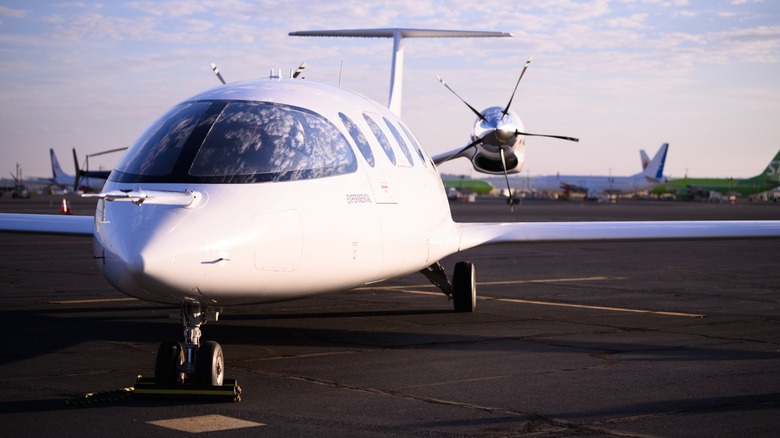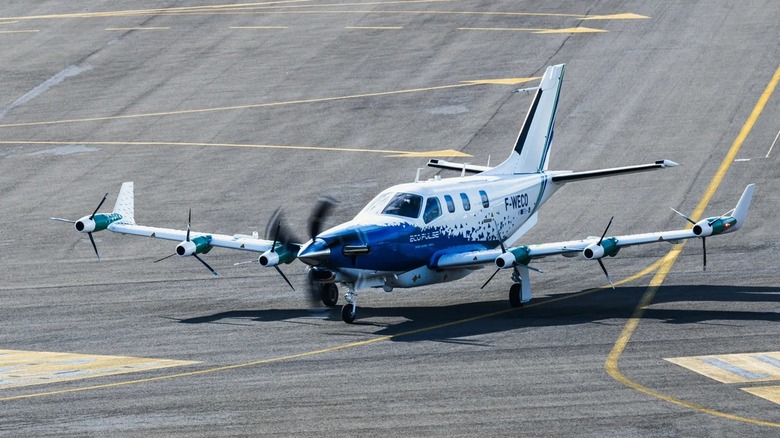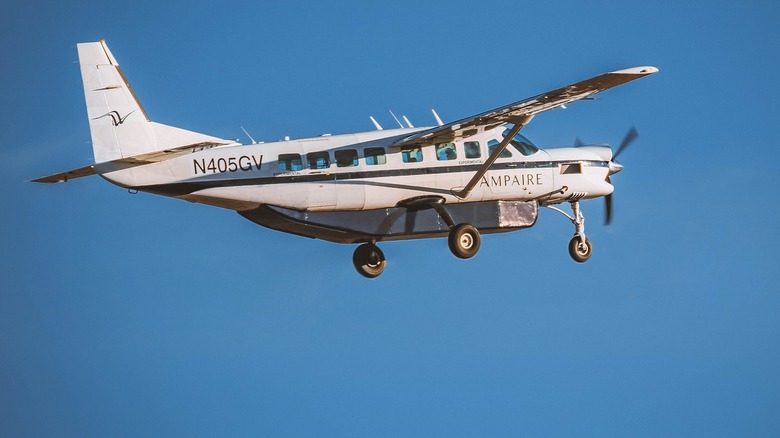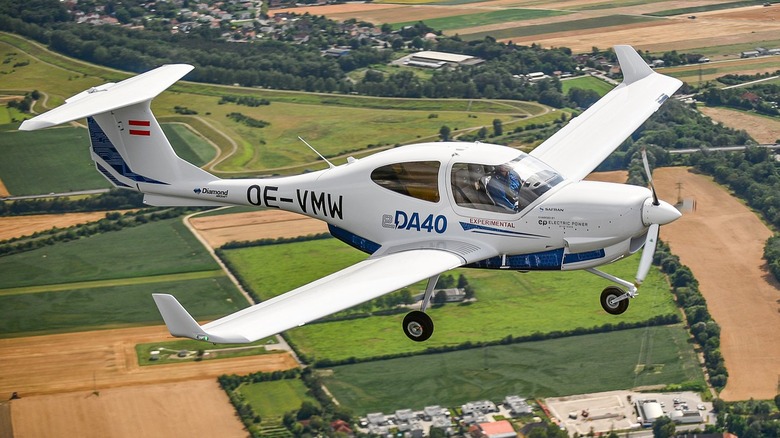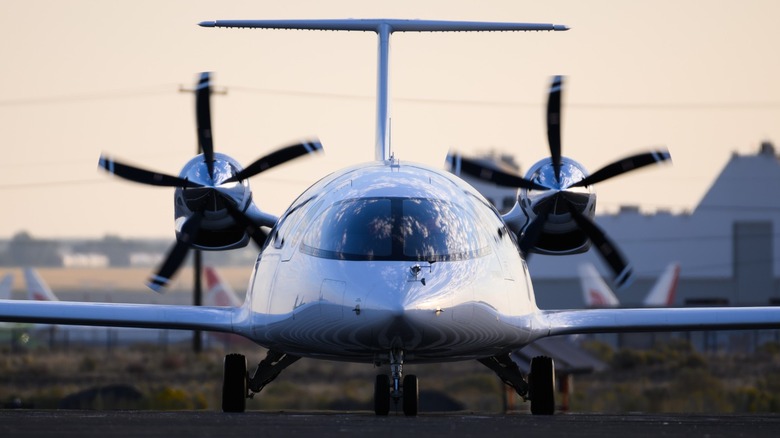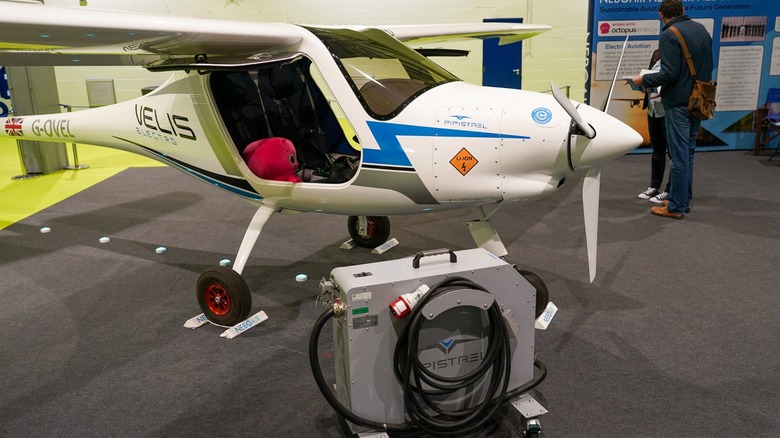5 Electric Planes That Will Take You To The Skies Soon
While electric cars and buses are quite popular nowadays, with Tesla becoming the best-selling luxury car brand in the U.S., it's still hard to find an electric plane to fly on. Nevertheless, as aeronautical engineers and aviation industry leaders recognize this, there is a push to develop electric planes.
Developing green technology is crucial, especially as aviation accounted for nearly 3% of global CO2 emissions in 2019. While this might seem a small percentage of the total, it's still over a billion tons of CO2 in the air. Furthermore, unlike jets and turboprops, most piston-engined planes still use leaded fuel, making it one of the biggest sources of lead pollution in the U.S. today. That's why electric planes are crucial to help the aviation industry clean up its act.
Let's examine the future of aviation with five electric and electrified planes that have already taken to the skies and are being developed further.
Airbus-Daher-Safran EcoPulse
Airbus is one of the two aviation giants today, with over 13,000 Airbus planes currently in service. As an industry leader, Airbus needs to stay ahead of the curve in electric aviation development so that another company doesn't get ahead of it and dethrone it as one of the major players in commercial air travel.
The company has already started research and built an all-electric plane, the Airbus E-Fan prototype, that crossed the English Channel. However, it canceled its successor project, the E-Fan X, during the pandemic. This wasn't a signal that Airbus was pulling out of the electric aviation game. Airbus partnered with Daher, the maker of one of the most popular turboprop singles today, and Safran, a huge global aerospace company.
Together, these companies made the EcoPulse, a distributed hybrid-propulsion demonstrator aircraft, which first flew on November 29, 2023. The EcoPulse uses a Daher TBM 900 turboprop as its base but features six additional electric engines (three on each wing) powered through batteries or a 100-kW auxiliary power unit. Although this is just a demonstrator aircraft, Airbus' success in this project might lay the foundations for a future electric-powered plane in Daher's TBM range of models.
Ampaire Eco Caravan
The Cessna 208 Caravan is a popular short-haul regional airliner that can seat nine people and has a 325-nautical mile range. It's also loved by cargo companies, with FedEx operating 231 airframes. Due to this, the Cessna 208 is a popular choice for electrification, with three different companies working on its transformation.
For example, AeroTEC and magniX conducted the first all-electric flight of its eCaravan in 2020, while Surf Air Mobility, which is developing a hybrid-electric Cessna Grand Caravan, ordered up to 150 airframes from Cessna in 2023 for its project.
Ampaire, on the other hand, is working on a plug-in hybrid Eco Caravan. The Eco Caravan made its first flight in 2022 and is expected to earn an FAA certification in 2024. According to the Aircraft Owners and Pilots Association (AOPA), the Eco Caravan flies on sustainable aircraft fuel taken from carbon dioxide, thus reducing its carbon footprint even more. Best of all, the Ampaire Eco Caravan engine can be retrofitted to any existing Cessna 208 Caravan, making it a relatively affordable way for operators to transition to a completely green fleet.
Diamond eDA40
Diamond Aircraft Industries, which makes one of the best planes for getting your private pilot's license, is developing the electric version of its popular DA40 single-engine aircraft. The eDA40, which is designed for training and personal aviation, uses an ENGINeUS electric motor from Safran and batteries from Electric Power Systems. The eDA40 made its first flight on July 20, 2023, and the company is expected to present it to the public at the AERO Friedrichshafen Airshow in April 2024. It's also at the final stages of certification from the European Aviation Safety Agency (EASA), so we expect this aircraft to go on sale in the near future.
If the eDA40 becomes a hit, it could make the general aviation (GA) industry much greener and cleaner. According to the AOPA, historically, a majority of GA flights in the U.S. are flown by single-engine aircraft. The most popular of which, the Cessna 172 Skyhawk, has over 44,000 units sold and counting. As the eDA40 is also a single-engine aircraft that can seat four passengers, just like the Cessa 172, it could become a future favorite, helping to reduce the carbon footprint of the GA industry.
Eviation Alice
All of the aircraft listed so far are based on existing models. The Eviation Alice is the first to be designed based on an electric propulsion system. The unique plane has an unusually shaped fuselage, propelled by two fans powered by electric motors mounted on the aft fuselage. A nine-seater twin-engine aircraft, it has a 250-nautical-mile range and a maximum payload of 2,500 pounds. It made its maiden flight on September 27, 2022, and is already undergoing certification. Eviation aims to be able to enter the model into service by 2027.
The Alice has already received orders worth over $5 billion, with major cargo operator DHL among them. It also has a solid leadership team, with former Embraer executive Andre Stein at the helm of Eviation. His 25 years of experience at Embraer, including the development of the Embraer E-Jet E2, prove his track record of bringing a new jet to market, and Eviation hopes that he will do the same with the Alice.
Pipistrel Velis Electro
The Pipistrel Velis Electro is a twin-seat, single-engine electric training aircraft that has already received its type certification. That means you can legally buy this electric plane today, use it for flight training, and build your hours. Although it's expensive at around $200,000 a piece, electric expenses make it very cheap to operate.
Like any other battery-powered vehicle, the Velis Electro's batteries need to be replaced after some time — specifically around 2,000 hours for this aircraft. The batteries cost $20,000 to replace, which is about the same price as the upper limit for a factory overhaul of a Cessna 152.
This small two-seater electric training aircraft has a maximum range of 50 minutes and a maximum ceiling of 12,000 feet. It can also reach a cruise speed of 98 knots and has a useful load capacity of 378 pounds. While it is still inferior to a Cessna, we're hoping recent advances in battery technology can bring the plane up to par in the near future.
